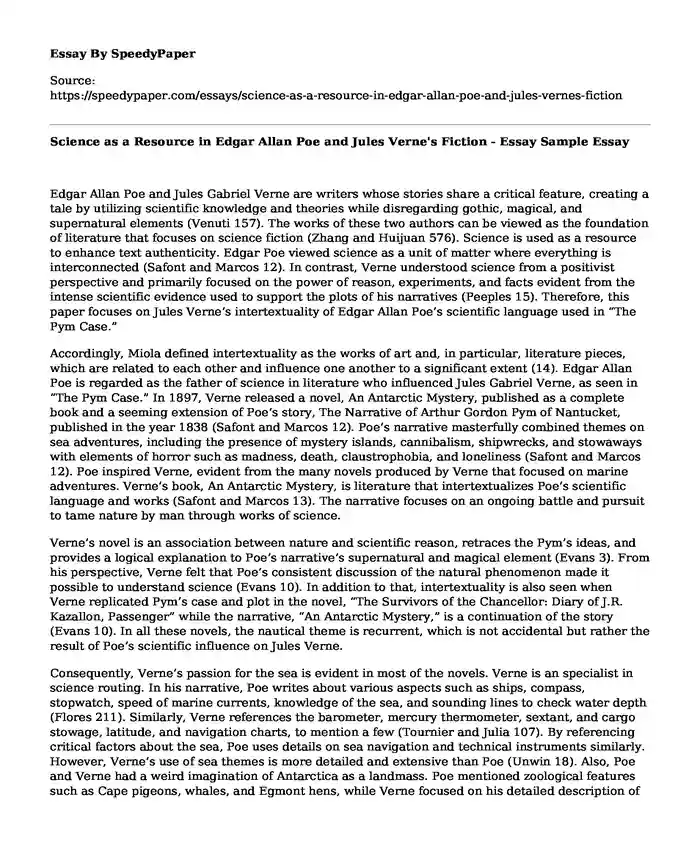
| Type of paper: | Essay |
| Categories: | Literature Science Edgar Allan Poe Writers |
| Pages: | 4 |
| Wordcount: | 895 words |
Edgar Allan Poe and Jules Gabriel Verne are writers whose stories share a critical feature, creating a tale by utilizing scientific knowledge and theories while disregarding gothic, magical, and supernatural elements (Venuti 157). The works of these two authors can be viewed as the foundation of literature that focuses on science fiction (Zhang and Huijuan 576). Science is used as a resource to enhance text authenticity. Edgar Poe viewed science as a unit of matter where everything is interconnected (Safont and Marcos 12). In contrast, Verne understood science from a positivist perspective and primarily focused on the power of reason, experiments, and facts evident from the intense scientific evidence used to support the plots of his narratives (Peeples 15). Therefore, this paper focuses on Jules Verne’s intertextuality of Edgar Allan Poe’s scientific language used in “The Pym Case.”
Accordingly, Miola defined intertextuality as the works of art and, in particular, literature pieces, which are related to each other and influence one another to a significant extent (14). Edgar Allan Poe is regarded as the father of science in literature who influenced Jules Gabriel Verne, as seen in “The Pym Case.” In 1897, Verne released a novel, An Antarctic Mystery, published as a complete book and a seeming extension of Poe’s story, The Narrative of Arthur Gordon Pym of Nantucket, published in the year 1838 (Safont and Marcos 12). Poe’s narrative masterfully combined themes on sea adventures, including the presence of mystery islands, cannibalism, shipwrecks, and stowaways with elements of horror such as madness, death, claustrophobia, and loneliness (Safont and Marcos 12). Poe inspired Verne, evident from the many novels produced by Verne that focused on marine adventures. Verne’s book, An Antarctic Mystery, is literature that intertextualizes Poe’s scientific language and works (Safont and Marcos 13). The narrative focuses on an ongoing battle and pursuit to tame nature by man through works of science.
Verne’s novel is an association between nature and scientific reason, retraces the Pym’s ideas, and provides a logical explanation to Poe’s narrative’s supernatural and magical element (Evans 3). From his perspective, Verne felt that Poe’s consistent discussion of the natural phenomenon made it possible to understand science (Evans 10). In addition to that, intertextuality is also seen when Verne replicated Pym’s case and plot in the novel, “The Survivors of the Chancellor: Diary of J.R. Kazallon, Passenger” while the narrative, “An Antarctic Mystery,” is a continuation of the story (Evans 10). In all these novels, the nautical theme is recurrent, which is not accidental but rather the result of Poe’s scientific influence on Jules Verne.
Consequently, Verne’s passion for the sea is evident in most of the novels. Verne is an specialist in science routing. In his narrative, Poe writes about various aspects such as ships, compass, stopwatch, speed of marine currents, knowledge of the sea, and sounding lines to check water depth (Flores 211). Similarly, Verne references the barometer, mercury thermometer, sextant, and cargo stowage, latitude, and navigation charts, to mention a few (Tournier and Julia 107). By referencing critical factors about the sea, Poe uses details on sea navigation and technical instruments similarly. However, Verne’s use of sea themes is more detailed and extensive than Poe (Unwin 18). Also, Poe and Verne had a weird imagination of Antarctica as a landmass. Poe mentioned zoological features such as Cape pigeons, whales, and Egmont hens, while Verne focused on his detailed description of zoological descriptions of whales, penguins, and birds in the novel.
In conclusion, Poe and Verne view science differently. Poe has a philosophical interpretation of science, while Verne understands it within the parameters of positivism and scientism. Science is used as a tool to increase text legitimacy while depending on scientific diction to enhance a narrative’s integrity. Verne has a detailed explanation of Poe’s texts and stories, but all have the same scientific ideas.
Works Cited
Evans, Arthur. “A Jules Verne Centenary || Jules Verne's English Translations.” Science Fiction Studies, vol. 32, no. 1, 2005, doi: 10.2307/4241322
Evans, Arthur. “Jules Verne in English: A Bibliography of Modern Editions and Scholarly Studies.” Verniana, vol. 1, pp. 9-21. http://www.verniana.org/volumes/01/LetterSize/ArtBiblio.pdf
Flores. “Edgar Allan Poe by Eduardo Mendoza.” The Edgar Allan Poe Review, vol. 15, no. 2, 2014, p. 211, doi: 10.5325/edgallpoerev.15.2.0211.
Miola, Robert. Seven types of intertextuality. https://loyolanotredamelib.org/Chaired/docs/SevenTypesIntextuality-04.pdf
Peeples, Scott. “International Poe bibliography: 1989-91.” Poe Studies, vol. 25, no. 1–2, 12 June 1992, pp. 10–36, doi: 10.1111/j.1754-6095.1992.tb00056.x
Safont, Bonet, and Marcos, Juan. “Science in Verne and Poe: The Pym Case.” Mètode Revista de Difusió de La Investigació, vol. 0, no. 6, 15 June 2015, doi: 10.7203/metode.85.3315.
Tournier, Michel, and Julia Abramson. “Jules Verne and around the World in Eighty Days.” World Literature Today, vol. 76, no. 2, 2002, p. 107, doi: 10.2307/40157274.
Unwin, Timothy. “Technology and progress in Jules Verne, or anticipation in reverse.” Journal of the Australasian Universities Language and Literature Association, vol. 93, no. 1, May 2000, pp. 17–35, doi: 10.1179/aulla.2000.003.
Venuti, Lawrence. “Translation, intertextuality, interpretation.” Romance Studies, vol. 27, no. 3, July 2009, pp. 157–173, doi: 10.1179/174581509x455169.
Zhang, Huanyao, and Huijuan Ma. “Intertextuality in retranslation.” Perspectives, vol. 26, no. 4, 2 Apr. 2018, pp. 576–592, 10.1080/0907676x.2018.1448875.
Cite this page
Science as a Resource in Edgar Allan Poe and Jules Verne's Fiction - Essay Sample. (2023, Nov 27). Retrieved from https://speedypaper.net/essays/science-as-a-resource-in-edgar-allan-poe-and-jules-vernes-fiction
Request Removal
If you are the original author of this essay and no longer wish to have it published on the SpeedyPaper website, please click below to request its removal:
- Creation vs Evolution Essay Example
- Essay Example on the Article The Trouble With Fries
- Theranos - Free Essay Example
- Literature Review on Steve Jobs Personality, Essay Sample
- Liberace the Musician Essay Sample
- Gene Editing On Human Embryos: Pros and Cons - Essay Sample
- The Symbolic Use of the Chrysanthemums - Free Essay Sample
Popular categories




